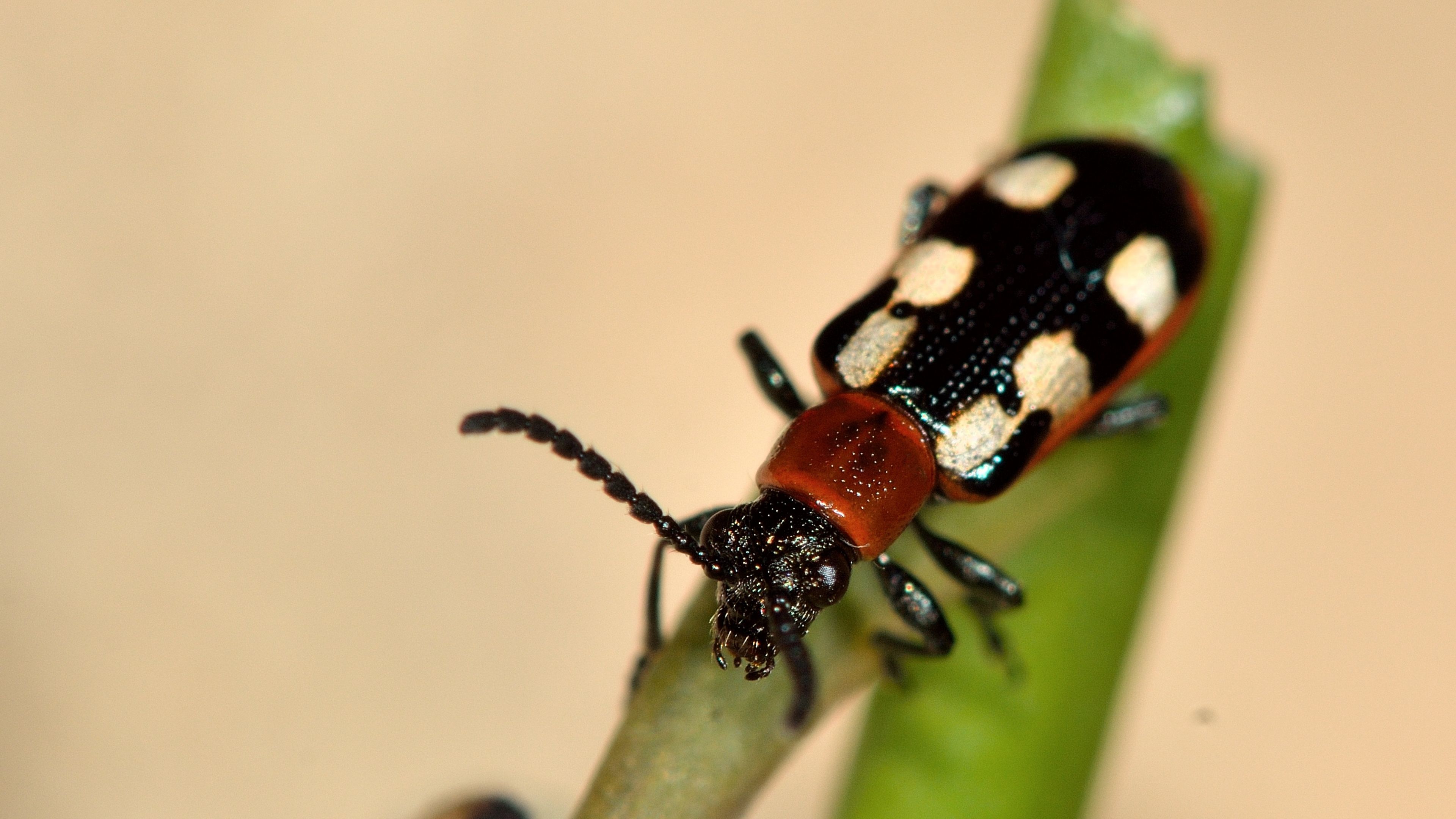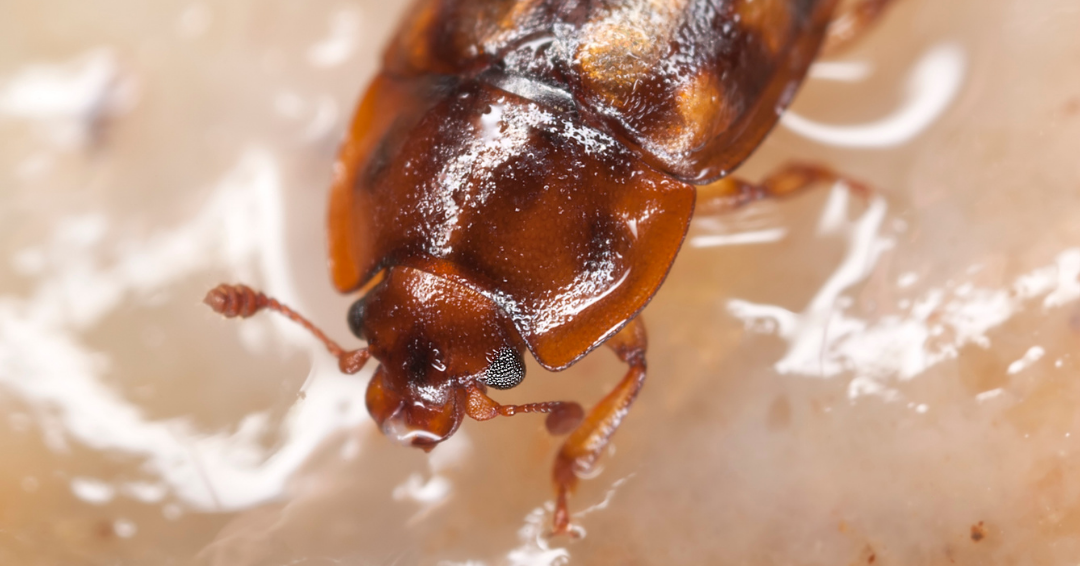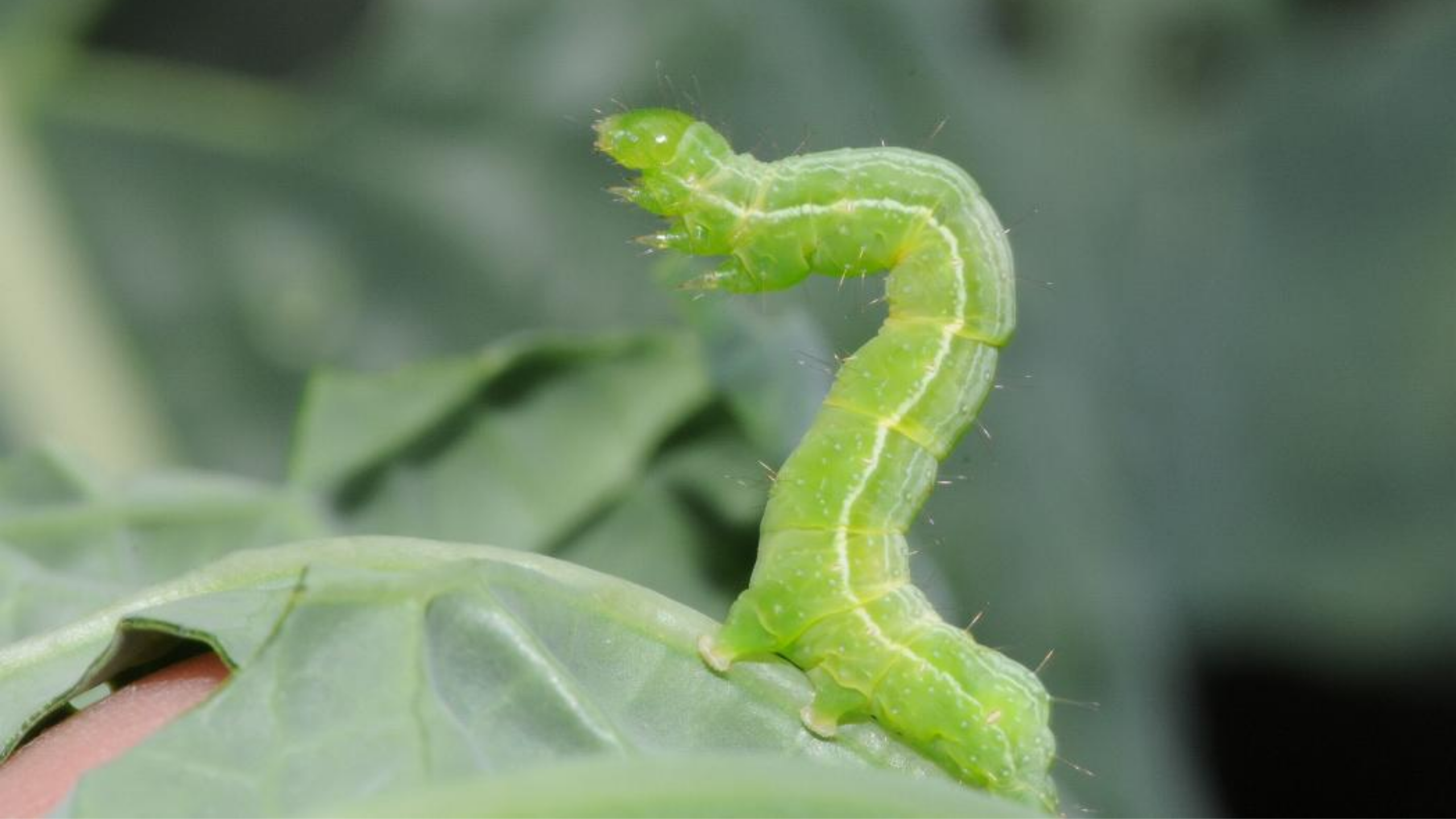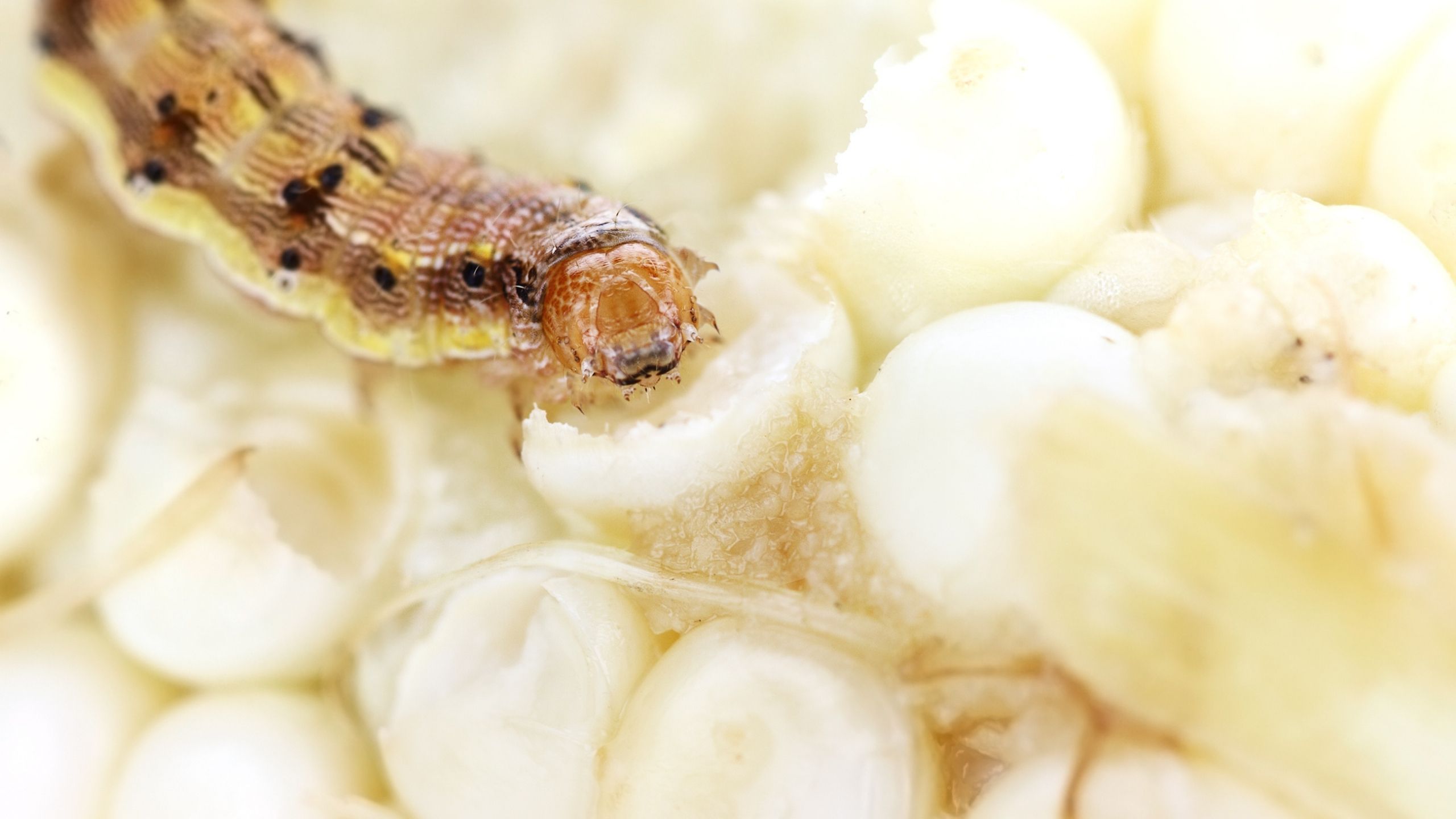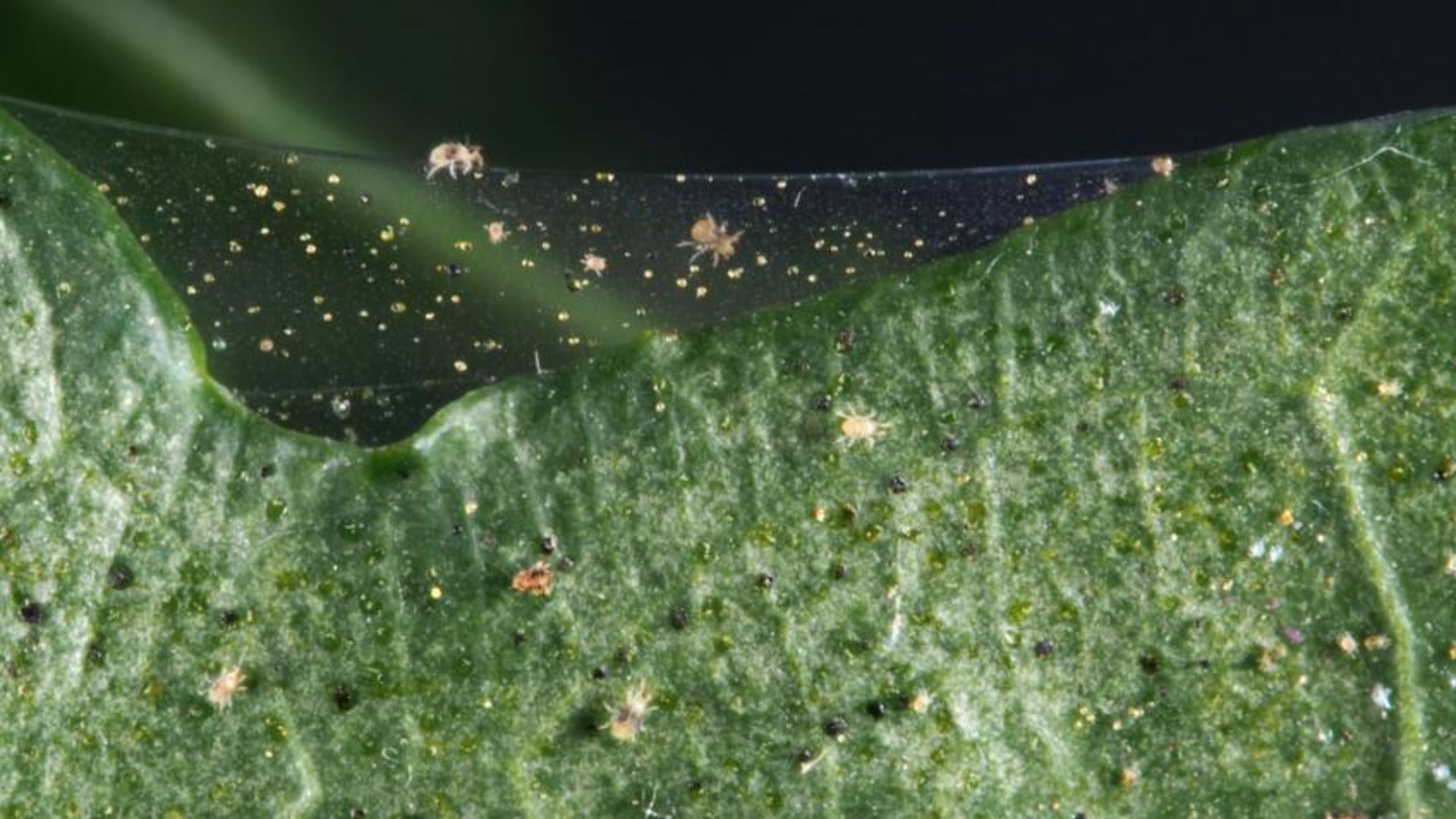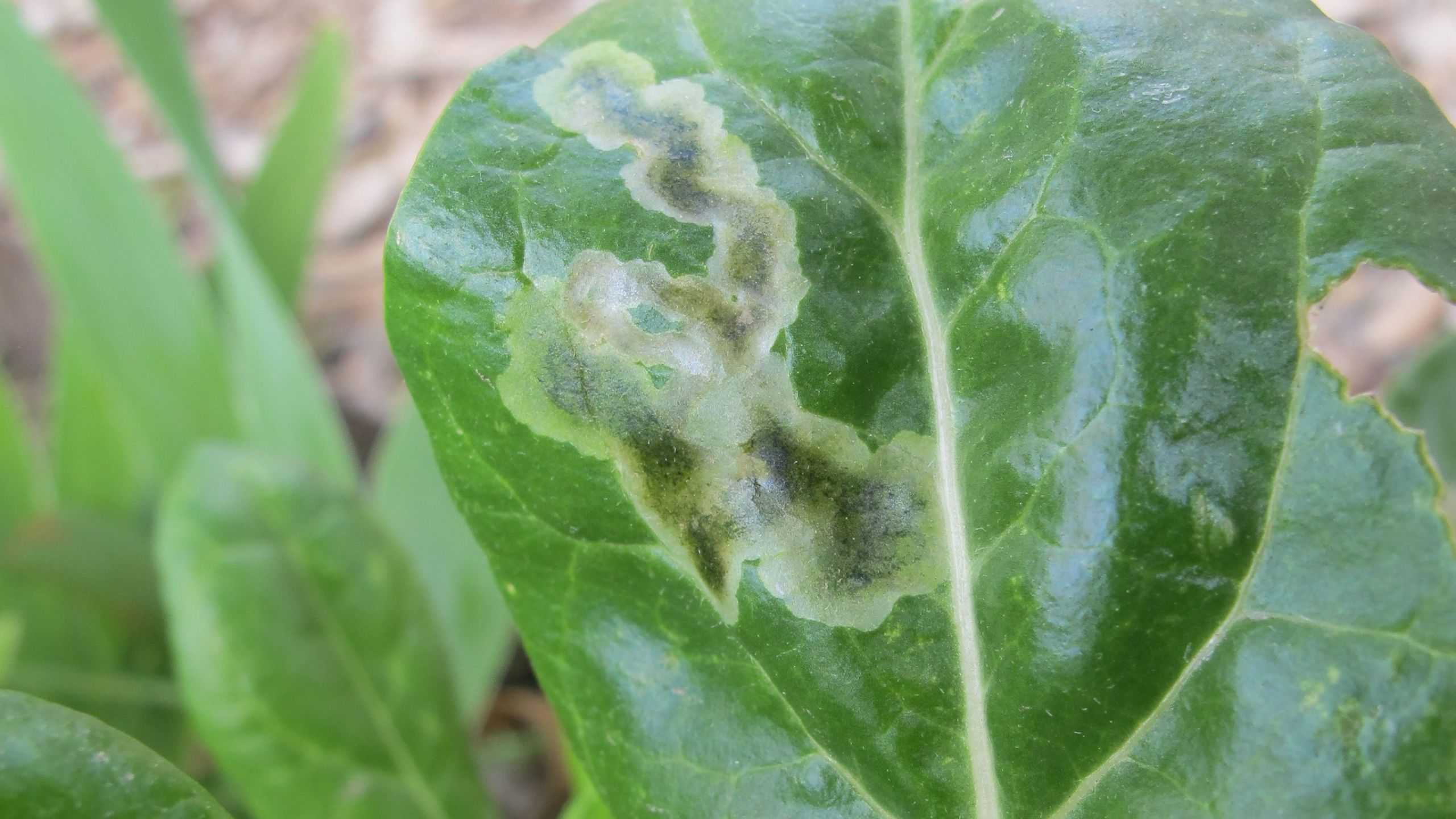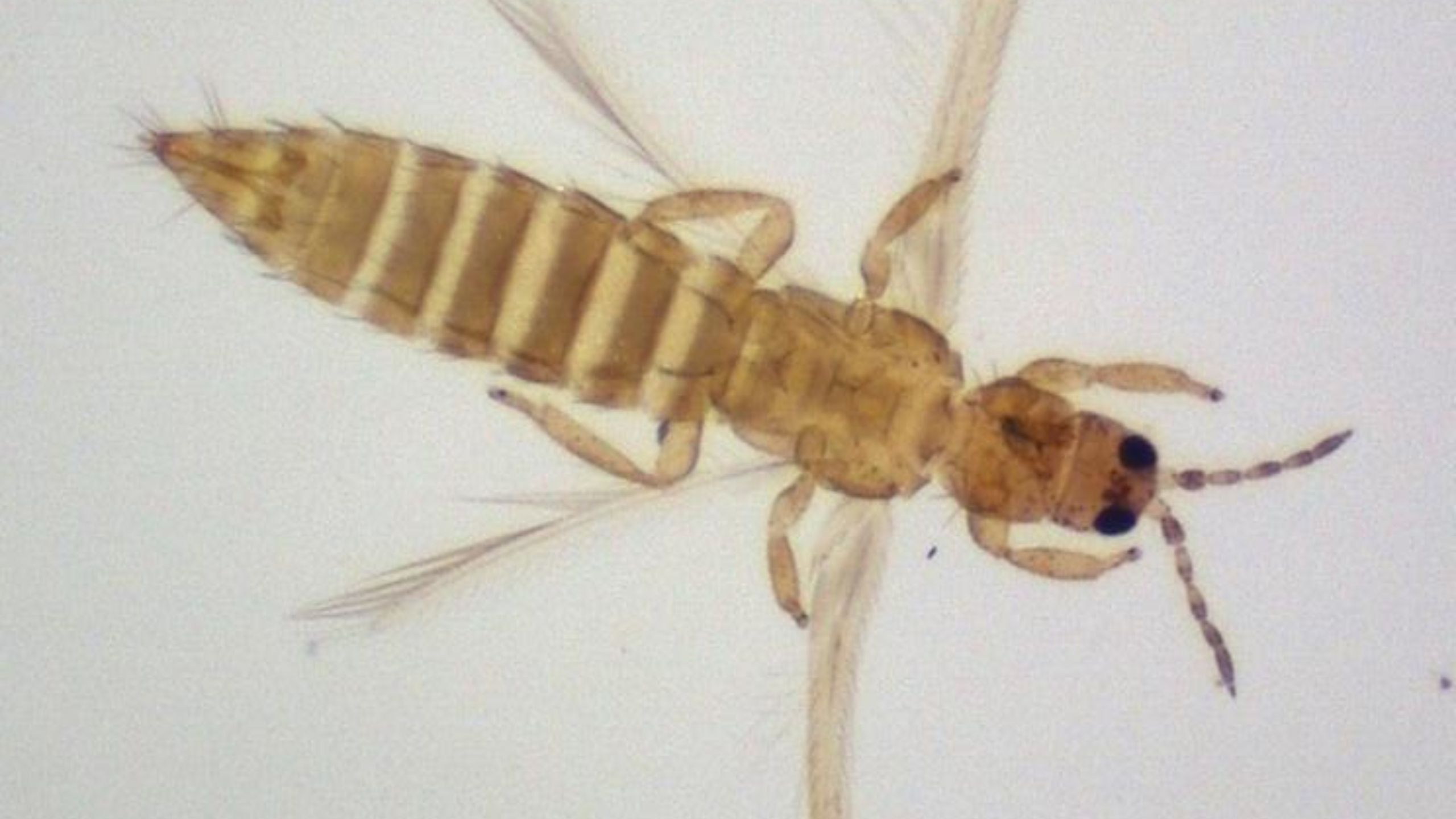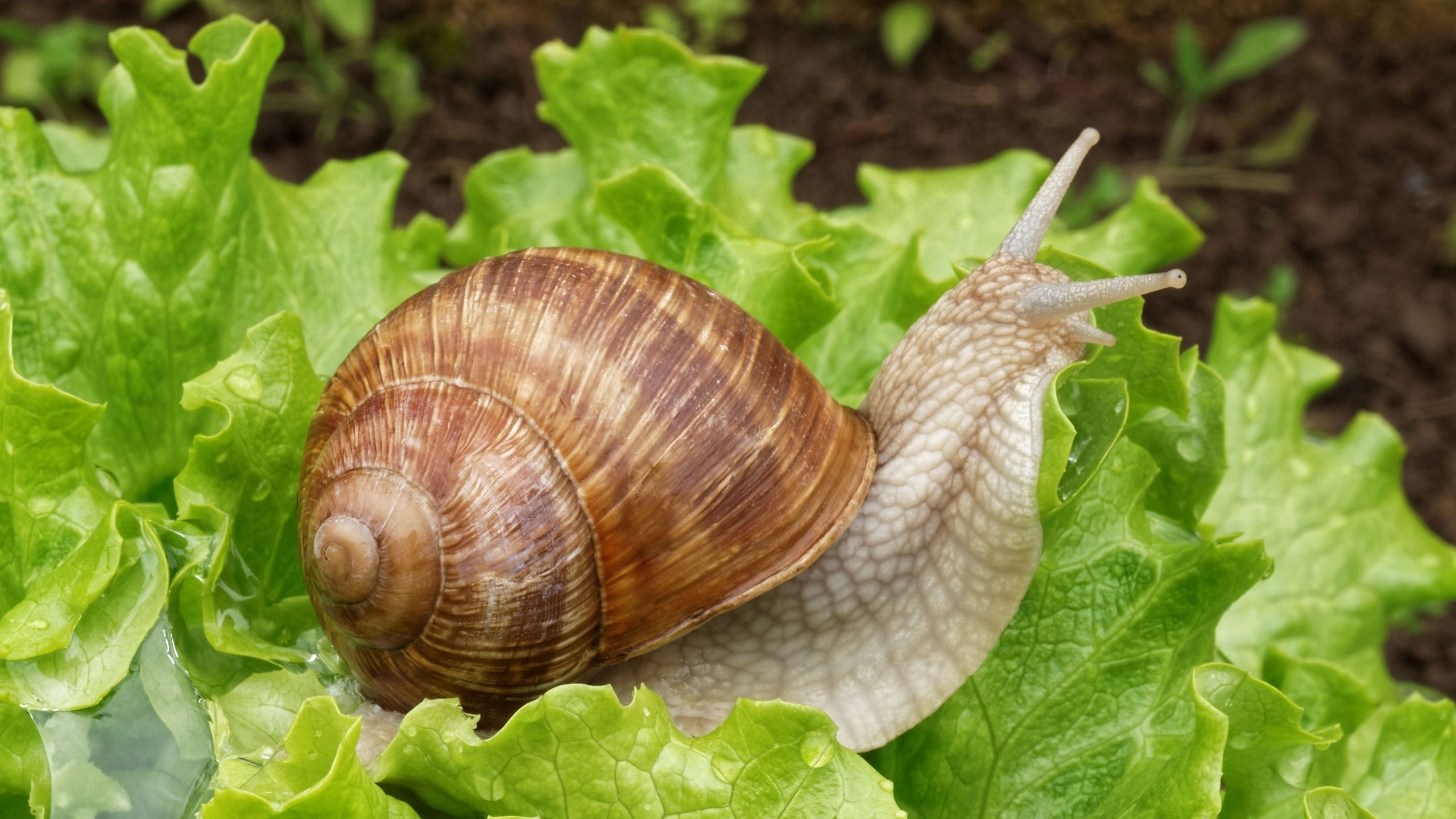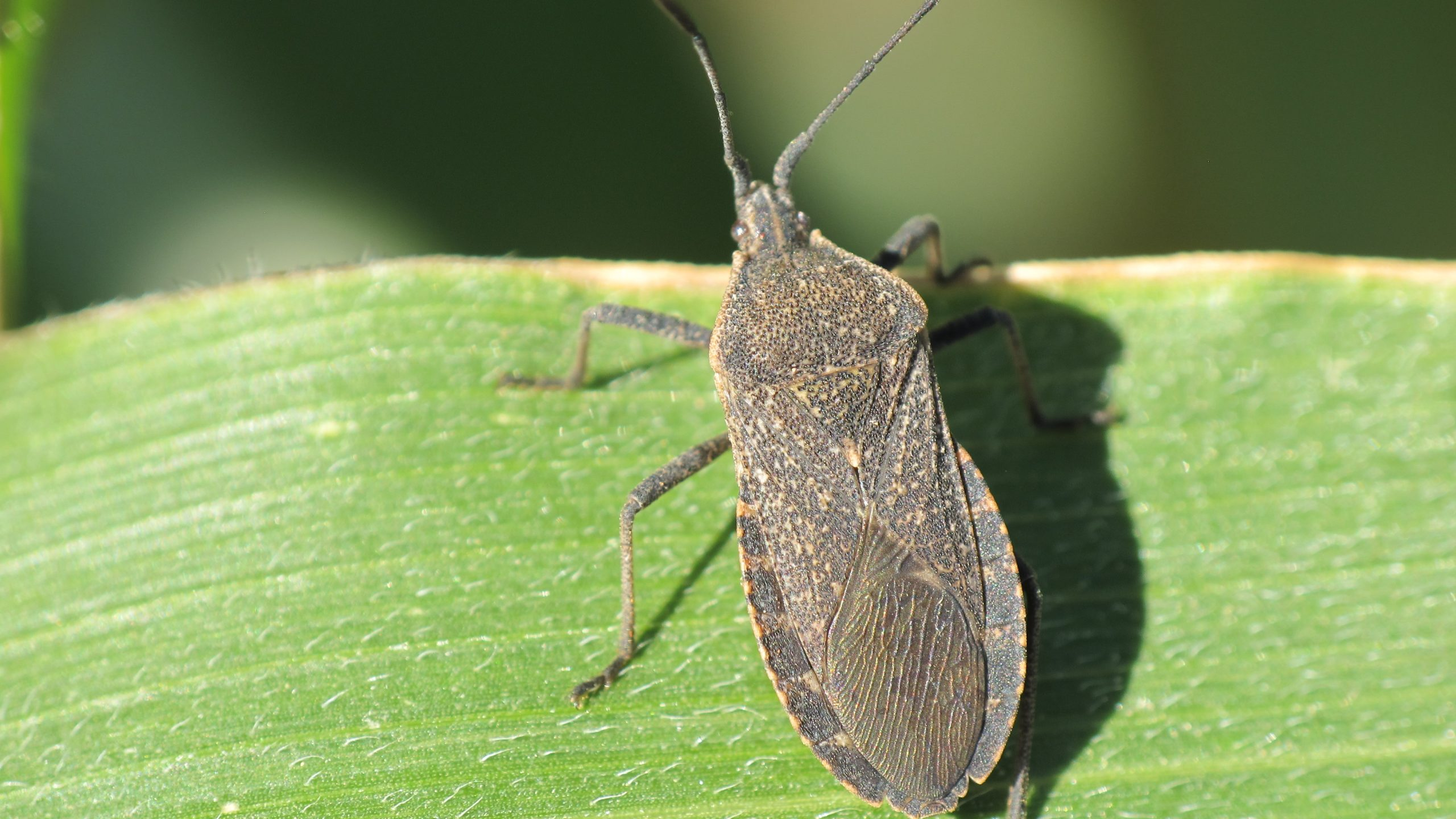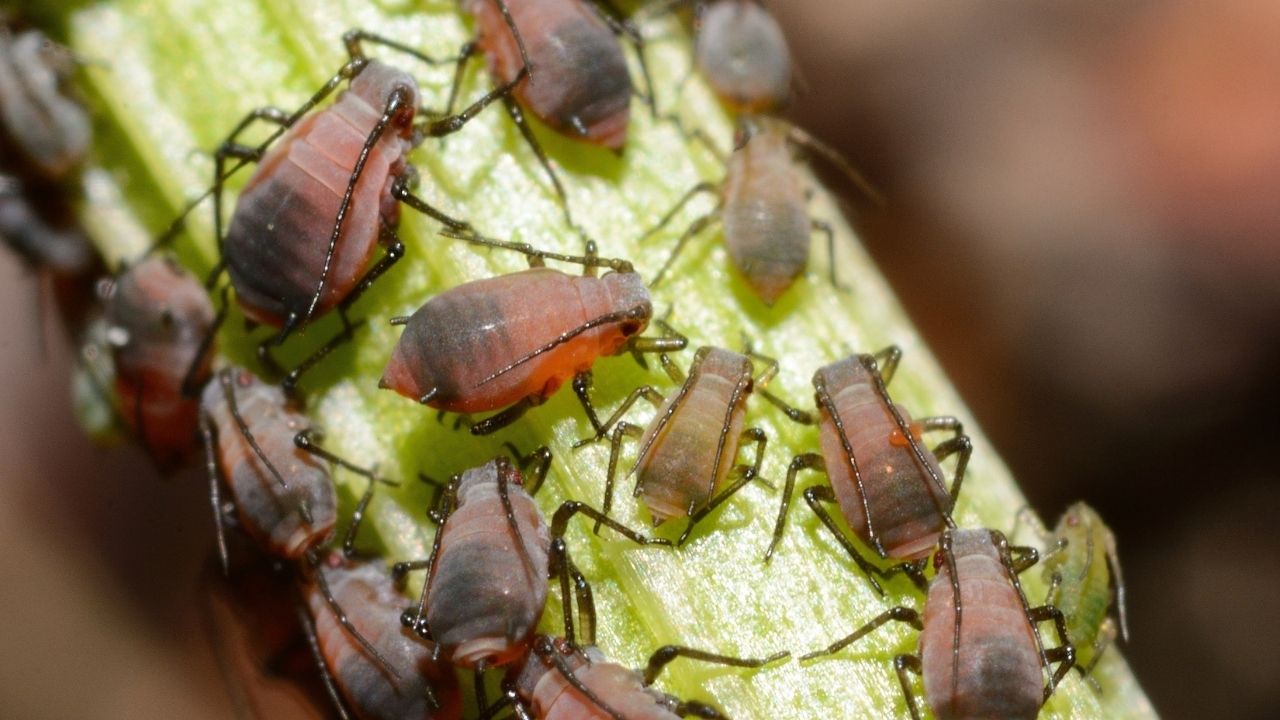Spider Mites in Corn:
Banks Grass Mites & Two Spotted Spider Mites
(Oligonychus pratensis & Tetranychus urticae)
August 2015
Alice Ruckert, USU Biology • Richardo Ramirez, Extension Entomologist (No longer at USU) • Clark Israelson, Extension Agriculture Agent (Cache County)
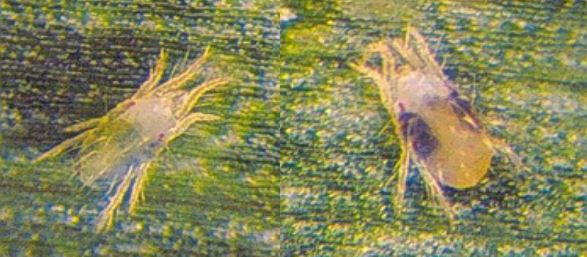
Fig. 1. BGM female on the left and TSSM female on the right. Image courtesy of University of Nebraska-Lincoln.
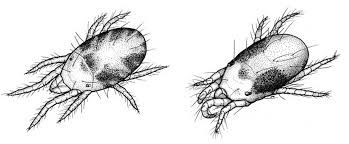
Fig. 2. Generalized spot patterns on BGM and TSSM. BGM (left) have less defined black spots that cover the entire sides of the abdomen, while TSSM (right) have two distinct dark spots on the anterior part of the abdomen. Image courtesy of J. Kalisch, University of Nebraska-Lincoln.

Fig. 3. Spider mite eggs. Image courtesy of L.D. Godfrey, University of California, Statewide Integrated Pest Management Program.

Fig. 4. Spider mite life cycle. Image courtesy of L.D. Godfrey, University of California, Statewide Integrated Pest Management Program.

Fig. 5. Spider mite injury on corn. A) Injury on the underside of the leaf, where yellowish spots are visible; B) Injury visible on the upper side of the leaf; C) Webbing covering mites and eggs; D) Desiccation of corn leaves caused by mite feeding in the first third of the plant. Image courtesy of (A) R. Parker, Texas A&M AgriLife Extension, (B) A. Szczepaniec, North Dakota State University, and (D) Peairs, Colorado State University, (Bugwood.org).
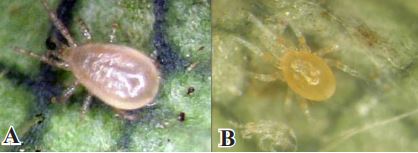
Fig. 6. Predatory mites. A) Phytoseiulus spp.; B) Neoseiulus spp. Image courtesy of R. Francis, Clemson Extension.
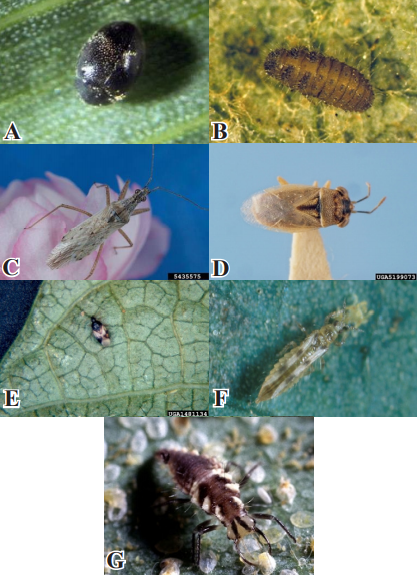
Fig. 7. Spider mite predators commonly found in corn fields. A) Spider mite destroyer lady beetle adult; B) Spider mite destroyer lady beetle larva; C) Damsel bug; D)Big eyed bug; E) Minute pirate bug; F) Sixspotted thrips feeding on a spider mite; G) Lacewing larva. Image courtesy of (A) F.C. Schweissing, (B) H. Riedl, Oregon State University-Mid-Columbia Research Center, (C) Joseph Berger, (Bugwood.org), (D) Kansas Department of Agriculture Archive, (Bugwood.org), (E) F. Peairs, Colorado State University, (Bugwood.org), (F) J.K. Clark, University of California, and (G) USDA ARS Photo Unit, USDA Agricultural Research Service.
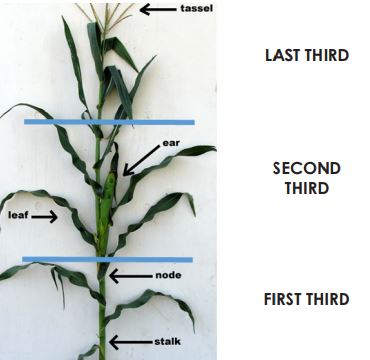
Fig. 8. Chemical control for spider mites in corn should occur when the injury is evident in the first third of the plant and colonies start to appear in the second third. Adapted from University of Nebraska-Lincoln. Image courtesy of University of Nebraska-Lincoln.
Quick Facts
- Banks grass mites and two-spotted spider mites are common pests of field and sweet corn and a wide variety of other plants.
- Prolonged hot and dry conditions promote spider mite development.
- The use of some pesticides, such as neonicotinoids and some organophosphates, can lead to spider mite outbreaks.
Banks grass mites (BGM) and two-spotted spider mites (TSSM) are important agricultural pests of corn and a wide variety of other crop, garden, and landscape plants. Usually they do not represent a threat, but under prolonged hot and dry conditions, or after the application of some pesticides, their population builds up rapidly and can cause severe economic losses. The damage is caused by mites feeding on the leaves and sucking out chlorophyll from cells, which lead to leaf desiccation. As a consequence, the plant growth is limited, the yield production is reduced, and the nutritive quality of silage is significantly decreased.
Identification
Spider mites are tiny arachnids (related to ticks and spiders) and distribute in clusters on the underside of corn leaves. BGM and TSSM have a similar appearance (Fig. 1). BGM has less defined black spots that cover the entire sides of the abdomen and can merge in some individuals, while TSSM has two well defined black spots on the anterior part of the abdomen. BGM has a slimmer body than TSSM and has a greenish tint, while TSSM appear cream colored. Differences, which are not visible to the naked eye, can be easily observed with a 10X hand lens.
Life History
There is one generation per year in northern Utah. A partial second generation may occur in southern Utah, but that hasn’t been documented.
Adult spider mites overwinter in the soil, litter, or weeds within and along corn fields. They disperse by crawling, or by being carried in wind currents. Females lay approximately 20 eggs per day and live for 2-4 weeks. Populations can develop exponentially in a very short period of time. TSSM adults appear earlier in the season and prefer slightly cooler temperatures (optimal 86-90°F/30-32°C) than BGM, which thrive under hotter weather conditions (optimal 96-99˚F/35.5-37°C).
Eggs are laid in clusters on the underside of corn leaves (Fig. 3). They are circular (0.10-0.15 mm diameter), initially translucent and white to cream colored just before hatching. Incubation varies from a few days to a couple of weeks, depending on the temperature. Higher temperatures accelerate mite emergence from eggs. Mites can also overwinter in the egg stage.
Larvae are as big as the egg and have three pairs of legs and no black spots on the abdomen (Fig. 4).
Nymphs resemble the adult. The protonymph has four pairs of legs and the black spots start appearing (Fig. 4). The deutonymph is the last immature stage before becoming an adult
Crop Injury
Injury commonly starts on the field edges and spreads into the field. Adults colonize the plant from the bottom and gradually move upward. The initial stage of mite colonization appears as stippling or yellowish-reddish brown spots on the leaves (Fig. 5 A-B), in correspondence with the location of the colony clusters found on the underside of the leaf. Leaves initially turn yellow (Fig. 5 B,C) and, with high population density, desiccate and die (Fig. 5 D).
Monitoring
Unfortunately, no predictive models to time treatments for BGM and TSSM in corn fields are available; therefore, it is important to frequently monitor mite populations.
Randomly collect leaves located on the first corn row and at 2, 4, 6, and 8 m (6, 12, 18 and 24 ft) from the edge;
- Examine the underside of the leaves;
- Check for yellowish-reddish brown spots, webbing (Fig. 5 C), and the mites;
- Repeat scouting every 10 days and, beginning 2 weeks before tasseling, scout every 2-3 days.
Management
Cultural Control
Some agricultural practices can help prevent developing mite populations, such as:
- Frequent and uniform irrigation to avoid drought stress; overhead irrigation to wash mites off; and monitoring after heavy rain events, which mechanically decrease mite abundance and reduce dust, which protects mites from predators.
- Removal of weeds which can host mites to delay the mite contamination of corn fields.
- Reduced fertilization, or more frequent application of lower nitrogen doses, since high nitrogen concentrations promote the development of mite populations.
Biological Control
Predatory mites such as Phytoseiulus spp. (Fig. 6 A) and Neoseiulus spp. (Fig. 6 B), are two of the most voracious predators of spider mites. They can be easily distinguished from spider mites since they are larger, have longer legs, and a teardrop body shape. Predatory mites occur naturally in corn fields and are a good curative agent, since they feed on all mite life stages, are very active and reproduce quickly. They are commercially available and represent an alternative to chemical treatments in small scale corn fields and gardens.Beetle predators are commonly found in corn fields and include lady beetle larvae and adults, and the spider mite destroyer lady beetle (Stethorus spp.)(Fig. 7 A, B). Although commercially available, some adult lady beetle species tend to fly away when applied.
Predatory bugs feeding on spider mites include damsel bugs (Nabis spp.) (Fig. 7 C), big eyed bugs (Geocoris spp.) (Fig. 7 D), and the commercially available minute pirate bugs (Orius spp.) (Fig. 7 E) which commonly appear in Utah.
Other mite predators include sixspotted thrips (Scolothrips sexmaculatus) (Fig. 7 F) and lacewing larvae (Fig. 7 G), which are also commercially available and naturally occur in corn fields.
Many of these predators are natural residents in the environment. It is important to limit the use of broad-spectrum insecticides, since these products can reduce predator populations that provide natural pest control and may lead to spider mite outbreaks.
Chemical Control
In general, chemical applications for spider mites in corn should occur before the formation of the kernel, when the injury is visible in the lower third of the plant and mites can be found in the middle region of the plant (Fig. 8). During grain formation (reproductive phase R1-R2), carbohydrates and nitrogen accumulate in the kernels. It is in R1-R2 phase that mites become an active competitor for plant nutrients. Rapid mite population growth usually occurs after pollen shed. The economic benefit of treatment diminishes after the R2 phase.
The use of chemicals to control spider mites, however, can induce negative side effects. For example spider mites can quickly develop resistance to pesticides. There are populations of TSSM and BGM, for example, that have developed resistance to bifenthrin and λ-cyhalothrin (pyrethroids), and to dimethoate (organophosphate), which is widely used in corn. Also, some neonicotinoids such as clothianidin and thiamethoxam, which are common seed treatments in corn for other pests, have been shown to increase mite abundance through stimulation of reproduction and changes in plant defenses.
For commercial corn fields, the available miticides include Zeal, Oberon 2 SC, Comite II, and Onager. Miticides primarily act by contact, therefore it is important that there is good coverage on both leaf surfaces. Miticides are more efficient when the mite population is relatively low and the plants can be easily sprayed by ground equipment. Application by air is possible, but limited to the upper layer of the canopy; therefore less efficient, since mites tend to occupy the lower part of the plant and the underside of the leaves.
CONSIDERATIONS BEFORE TREATMENT
- Is the crop near tasseling?
- Are leaves starting to desiccate in the first third of the plant due to mite feeding?
- Are the daily high temperatures expected to be above 95 degrees?
- Is the field suffering from drought stress?
- Does the field have a history of mite problems?
- Are predator populations low?
Adapted from Colorado State University (Peairs 2014). Respond to the following questions before scheduling a chemical treatment. If at least three of these questions receive a “yes” answer, a treatment may provide an economic benefit to growers. These considerations do not differ among field and sweet corn and the scale of production.
Other pesticides that are commonly used to control spider mites are the broad spectrum insecticides dimethoate, Hero and Portal. It is important to reduce the use of these insecticides since they can reduce the density of mite predators and lead to mite outbreaks. Also, development of resistance has been observed in some mite populations after treatments with dimethoate
In order to prevent spider mites from developing resistance to pesticides, it is a good practice to treat only when strictly necessary, and switch between two or more products with different modes of action (the way in which the pesticide kills the mites).
For small scale corn fields (gardens), other products can be used, such as insecticidal soaps, horticultural oils and sulfur. Be aware that phytotoxic effects (plant burn) can occur from applying these products. Monitoring, preventive control practices and biological control can also help maintain low levels of infestations
Table 1. Principal pesticides used in large scale corn fields against spider mites and their mode of action. * Broad-spectrum insecticides
which should be rotated with other products over time, due to the risk of reducing mite predators. Cases of population resistance development have been observed with dimethoate and bifenthrin.
| Brand Name | Active Ingredient | Activity | Targeted Life Stage | Mode of Action |
|---|---|---|---|---|
| Oberon 2 SC | Spiromesifen | Contact and translaminar |
All life stages | Inhibition of lipid biosynthesis |
| Comite II | Propargite | Contact | Juveniles & adults | Inhibition of ATP synthesis |
| Onager | Hexythiazox | Contact | Eggs & juveniles | Growth regulator |
| Zeal | Extoxazole | Contact and translaminar |
Eggs & juveniles | Growth regulator |
| Hero* | Bifenthrin & zetacypermethrin | Contact | Adults & juveniles | Alteration of sodium channels |
| Dimethoate* | Dimethoate | Systemic and contact |
Adults & juveniles | Cholinesterase inhibitor |
| Portal* | Fenpyroximate | Contact | All life stages | Mitochondrial electron transport inhibitor |
Further Reading and References
- Alston, D.G., and M.E. Reding, 2011. Web spinning spider mites. Two-spotted Spider Mite (Tetranychus urticae) &
McDaniel Spider Mite (Tetranychus mcdanieli). Utah pest fact sheet ent-151-06. Utah State University. - Cranshaw, W.S. and D.C. Sclar, 2014. Spider Mites. Fact Sheet no. 5.507. Colorado State University Extension.
- Godfrey, L.D., 2011. Spider mites. Integrated Pest Management for Home Gardeners and Landscape Professionals. Pest Notes 7405. University of California, Agriculture and Natural Resources, Statewide Integrated Pest
Management Program. - Israelsen, C., 2015. Spider mites pop up in local corn fields.
- Peairs, F.B., 2014. Spider Mites in Corn. Fact sheet no. 5.555. Colorado State University Extension.
Related Research


